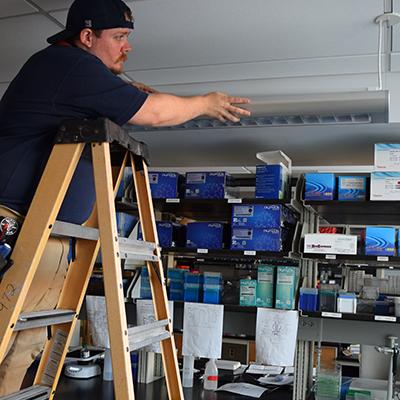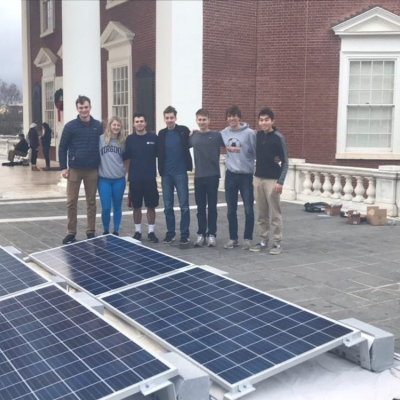Energy
The University aims to reduce energy consumption by 20% across it’s building portfolio.
Energy literally powers the University. Whether it’s keeping the library warm and bright during a late-night study session or running cutting-edge medical imaging devices, energy is essential to UVA’s mission, yet it comes with broader impacts. Traditional sources of energy including fossil fuels emit local air pollutants as well as contribute to global climate change.
UVA promotes the sustainable and responsible consumption of energy throughout its operations by making buildings more energy efficient, reducing the impact of energy production and increasing purchases of renewable energy. These programs and policies also reduce operational costs over time.
Buildings
Over 95% of the University’s energy footprint can be attributed to buildings. While it’s essential to keep buildings comfortable and equipment whirring, there are many opportunities to reduce building energy consumption and impact through efficiency initiatives and low-energy design.
UVA’s Building Efficiency Program (formerly known as the Delta Force program) was established in 2009 to identify and implement energy efficiency upgrades in existing buildings. Since then, the program has saved the University tens of millions of dollars and hundreds of thousands of tons of carbon dioxide emissions. Additional building energy efficiency programs include the Smart Labs, Smart Clinics and Green Workplace programs. The UVA Green Building Standards (see chapter 8 of the UVA Facilities Design Guidelines) requires high performance, low-energy design for all new buildings and major renovations.
See our Buildings page for more.
District Energy Systems
Centralizing energy systems across Grounds allows the University to take efficiency and sustainability to the next level. Instead of heating and cooling hundreds of buildings using separate systems in each one, the University operates heating and cooling facilities by districts.
These facilities operate at a much higher level of efficiency than individual systems and introduce entirely new methods of sustainable energy consumption. Combining a cold dormitory and a hot data center on the same district energy system, for example, allows the data center to heat the dormitory and the dormitory to cool the data center for “free” in a process called heat recovery.
Renewable Energy
While we aim to minimize energy consumption on Grounds, UVA is also seeking to procure clean, renewable energy sources to provide the power necessary to run the University. As of 2023, approximately 15% of UVA’s electricity comes from solar energy sources, including six on-site rooftop installations and two large off-site solar farms. More information about each of these systems can be found on UVA’s Renewable Energy Tracker.
------------------------------------
We are proud to have received a number of designations and award for the combined efforts of multiple UVA partner entities as we continue to move the University toward achieving the goals in the UVA 2020-2030 Sustainability Plan.
- Top 25 Renewable Energy Leader – EPA Green Power Partnership
- Virginia Energy Efficiency Leadership Award
- International District Energy Association Innovation Award
Energy Resources
- Facilities Management Energy & Utilities
- Building Energy Performance Requirements
- Renewable Energy Tracker
- Energy & Water Tracker
- Tour UVA's Solar Panels (video)


